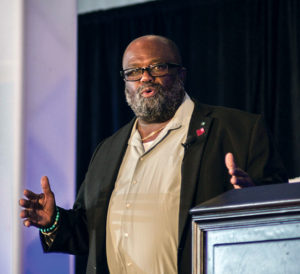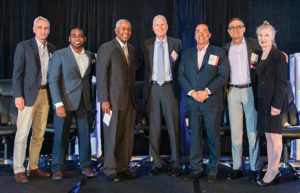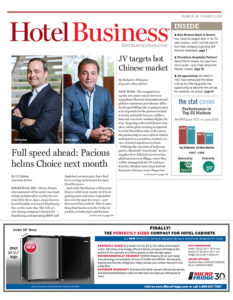MIAMI—It was all entrepreneurs on deck here at the Miami Marriott Biscayne Bay, where the National Association of Black Hotel Owners, Operators & Developers (NABHOOD) hosted its 21st annual International African American Hotel Ownership/Multicultural Tourism Summit and Trade Show.
More than 450 owners, investors, developers, hotel franchise company executives, political representatives, students and vendors descended on this vibrant city for the three-day event, which examines what it takes to be successful in the lodging space. Attendees, from industry “newbies” to seasoned veterans, were offered a variety of informational sessions, workshops and panels—including a separate, dedicated track for students, who are offered scholarship opportunities—targeting industry trends and issues of interest.

Andy Ingraham, NABHOOD’S founder/president/CEO, gave an update on the association’s progress during the general session.
“We are here in terms of looking at this industry to be very clear on how we can play a larger role—and a more impactful role—from an ownership perspective, not from an employee perspective,” said Andy Ingraham, the association’s founder/president/CEO, noting 823 hotels are now owned by African-Americans, up from last year’s Summit count of 753. “We are in every facet of the industry,” he said, citing a range from B&Bs to convention hotels.
In addition, Ingraham said more than 30 agreements have been signed with African-American organizations “to meet at our hotels. We’re going to continue to take advantage of the $90 billion spent by minorities in this country; we want them to meet at our hotels.”
Among the numerous sessions was a panel that gave a “View from the Top” by veteran hotel executives. The panel, moderated by Hotel Business Executive News Editor Stefani C. O’Connor, was composed of Roger Bloss, EVP/president, global development, RLHC (Red Lion Hotels Corp.); Bill Fortier, SVP of development-Americas, Hilton; Norman Jenkins, president, Capstone Development LLC and NABHOOD board member; Richmond McCoy, president/CEO, UrbanAmerica LLC; Julius Robinson, SVP, global brand leader-Marriott Hotels, Sheraton, Delta Hotels, for Marriott International; and Raj Trivedi, EVP/chief development officer, La Quinta.
With an audience eager to play in the lodging arena, Jenkins cautioned, “The first thing you need to know about investing in hotels is that it’s not for the faint of heart; it’s difficult. But what I’ve seen over the many years I’ve been in this business is you can create value; in other words, you can make money in this business in any market. You just have to be strategic in terms of how you invest your money before you invest [and]what you do with leverage.”
McCoy, whose company develops and invests in urban markets, said aspiring hoteliers and developers often come to him with deals and opportunities, thinking they need equity. “I suggest many times it’s not equity that’s needed, it’s capacity. Capacity can come in a lot of different forms. That’s really the key. If you put the capacity partners together—your flag, your operating company and you have a really great market—you can attract the capacity you need that will bring credibility to your project,” said McCoy, indicating finding the monetary component theoretically becomes a simpler process. “I always reverse the process in terms of looking to how to get into the business and become an owner,” he added.
“I think one of the really important things that people should think about is being in their own backyard,” said Bloss. “A lot of people go out looking at markets or places that they think will do well. We always encourage people to stay close to home where they know their business, they know their surroundings, where they have resources.”
With four of the panelists’ companies representing more than 50 brands, Fortier suggested to the audience choosing the right one need not be overwhelming. “Most brands have pretty specific definitions of the swim lane,” said Hilton’s SVP. “You take a look at a market and…you have to know what you’re getting into. What are the demand generators? What else is available in that market today, and what niche can you build? Most of us have a brand that can fill that niche. Talk to your development team members and consultants, and they can give you an idea. You don’t want to go in and say: ‘I’m going to build this and that’s all I’m going to think about.’ You might be building the wrong product for that market.”
He pointed out financing is getting tighter and many markets are getting saturated with product. “There are a lot of hotels that are going be opening in the next couple of years and occupancy rates [and]average rate are going to continue to go down in some markets. So you really have to think long and hard about what you’re doing,” he said.
With 30 brands, Marriott International has a variety of choices for hotel entrepreneurs, noted Robinson.
“Many of the brands we talk about up here are select-service or extended-stay brands that really afford you an opportunity to build them quickly [and]avoid some very difficult food and beverage and meeting space, as well as other elements of the project. You want to find opportunities that afford you an opportunity to be in a market—a local market. I would certainly agree with that—where you can maximize the value, where you know something that other people don’t,” said Robinson.
Jenkins again advised that while the so-called “backyard” hotel play is viable, hoteliers need to make sure the market where they want their project is viable in itself, with robust demand generators. With the right asset manager, he said, an owner could pursue opportunities beyond the local perimeter.

The “View from the Top” presentation at NABHOOD included (left to right) Bill Fortier, Hilton; Julius Robinson, Marriott International; Norman Jenkins, Capstone Development LLC; Roger Bloss, RLHC; Richmond McCoy, UrbanAmerica LLC; Raj Trivedi, La Quinta; and moderator Stefani C. O’Connor, Hotel Business.
“I think key is just not to get interviewed by the brand, but interview brands as well,” said Trivedi, urging the attendees to understand what the brand can produce for an owner, as well as the cost of construction, what resources are available, how many rooms from the same brand are in proximity, the fee structure, the liabilities if the project is not a success and what kind of support is coming from the chain.
Drill downs on industry fundamentals were given by Raquel Ortiz, senior analytics manager, STR; Robert Mandelbaum, director of research information services, CBRE Hotels’ Americas Research; and John Lancet, associate managing director, HVS International.
“RevPAR for the industry is up 2.8%, due to the high ADR increase for June, which is up 2.1%,” said Ortiz. “June, so far this year, [had]the highest occupancy, 73.4%, as well as the highest June room demand ever: 113 million room nights.”
Although, over the past 12 months, room supply increased 1.7%, it was outpaced by demand, up 2.2% through June, according to STR.
Mandelbaum said CBRE’s outlook was similar, noting there would be “growth, albeit at a slower pace than what we’ve seen in the past few years.”
He noted concerns for hotel owner/operators likely would stem from “supply growth in certain markets, the ability to grow ADR and expenses… If your revenue is growing at 2-3%, there’s not a lot of room there to allow your expenses to grow. We saw in 2016, 2.4% growth in total revenue for hotels that participated in our ‘Trends’ sample, the lowest revenue growth since the depths of the recession in 2009. Fortunately, hotel owners did do a good job and did control their expenses to limit the increase in growth of the costs to just 1.6%.”
Mandelbaum cited labor as the “biggest, single expense for a hotel,” incorporating salary/wage and employee benefits components.
Lancet indicated hotel “sales transactions are down in 2017,” down year-to-date approximately 5% in overall sales activity. “What we haven’t seen is a lot of portfolio sales, which is driving this decrease in transactions volume,” he observed.
With tourism-centric Brand USA facing potential elimination under the current administration’s budget, Mike Fullerton, the destination-marketing organization’s director of public affairs, gave insight about the importance of educating international travelers about changes related to visiting the U.S.
“Our goal is to increase international visitation. Every 33 overseas visitors creates one new job; the average spend is $4,500 a person… It’s very good for the economy, and tourism is a Top 10 employer in 49 of the 50 states,” he said.
On a local level, State Senator José Javier Rodríguez, a Democrat running for Florida’s 27th Congressional District to replace U.S. Rep. Ileana Ros-Lehtinen, who is retiring, touched on the role of Visit Florida; Airbnb’s impact; and casino development in Downtown Miami. “For me, supporting the industry is a no-brainer; it’s the backbone of a big part of our economy in Florida, especially in Miami,” he said. HB

